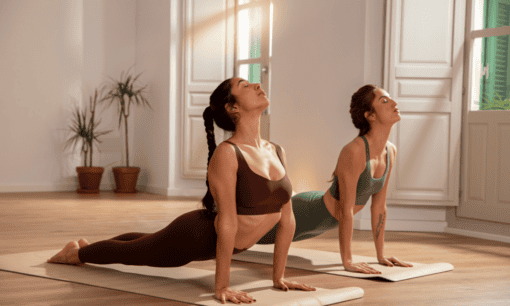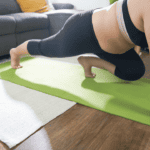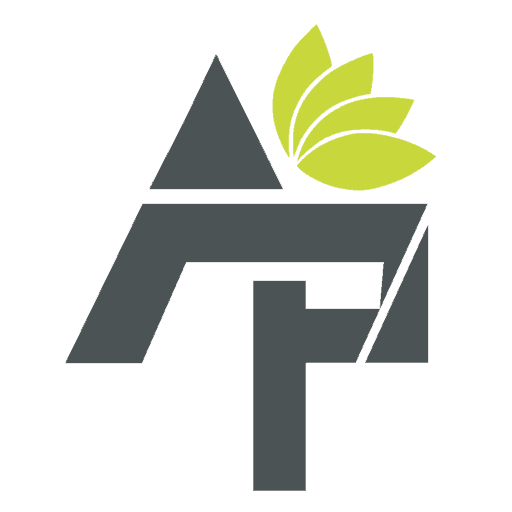I love yoga.
I’ve been taking yoga classes and practicing yoga at home, even teaching classes to friends and community members for free for about the last 12 years. Once upon a time, about 10 years ago, my best friend became a certified yoga instructor and worked in a yoga studio.
I couldn’t be bothered to join her, though. I was certain that getting paid to do something that was very personal to me would take away the joy.
After a few years, I was asked to lead yoga classes for things like church events or community events, and these turned out to be a lot more fun than I thought. It was a bit of a challenge at first to adapt the yoga I do for myself to things like senior citizens who need to do chair yoga. That’s about the time I realized I needed to get certified, and maybe a certification would help fill those needs.
Thankfully, I was right.
I looked around but ended up picking the ISSA Yoga Fundamentals course, and it turned out to be a great investment. Let me share why.
Topic Contents
The ISSA Yoga Fundamentals Course
ISSA offers two Yoga courses.
The first is the Yoga Fundamentals course. This course blends yoga Theory with science and practical application to help teach about different yoga poses and how those poses might be adjusted for different students.
This course includes templates that can help you build customized classes and start teaching basic yoga practices, including yoga for all levels, pranayama, and breathing techniques.
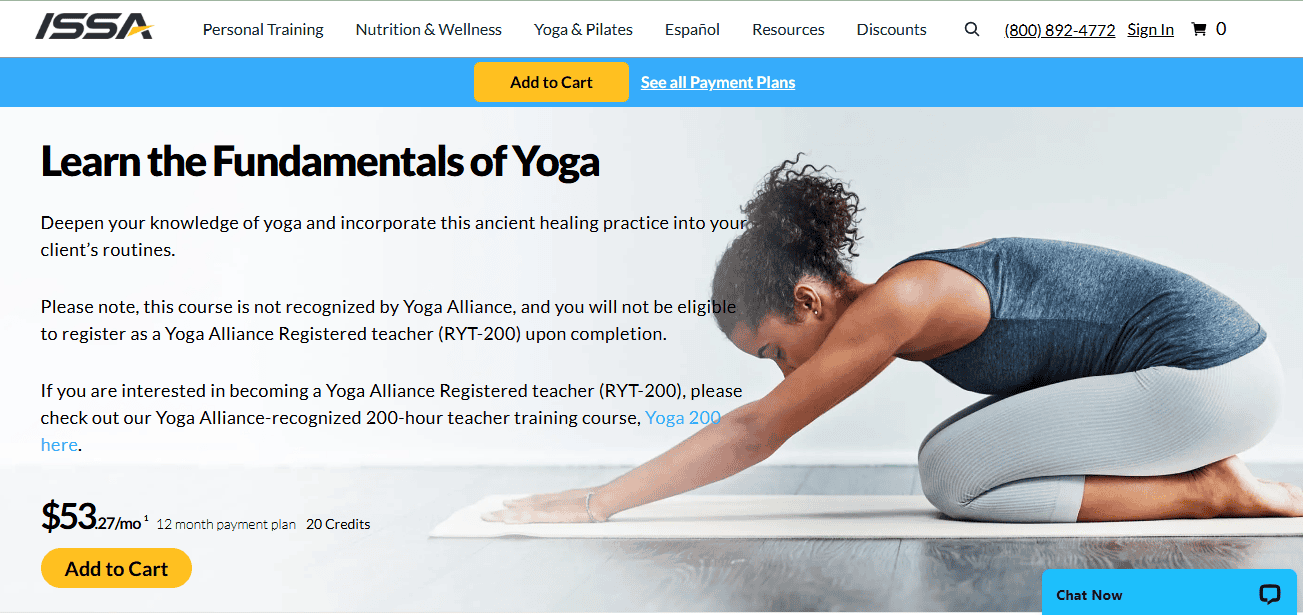
Cost
- Around $650
What is Included in the Cost
- An entirely online platform that you can use to learn at your own pace (but they have suggested weekly modules)
- You get video content and audio files to accommodate each chapter
- Weekly live Zoom sessions (but recordings are available later if you can’t make it)
- A complete exercise video library where you can watch more detailed exercises
- At home quizzes after each; you have to complete each quiz, but they don’t count toward your pass/fail score
- An untimed and open-book final exam; if you fail the first time, you can retake for free
- Professional support where you can find jobs and start working right away
- Downloadable documents you can use as a coach right away, like sample class sequences, client intake forms, and client design templates
- Discounts on other Yoga resources like AloMoves
CE Credits
- 20 credits–If you have any other certification and you need continuing education units to keep your certification current, this course will fulfill your needs with ISSA and many other companies
What I Love
- Very good incorporation of videos, audio, images, and text throughout the entire course
- Every course starts with meditation to set your intention
- Each week, they offer live Zoom study sessions with Q&A from students, which are recorded and accessible after the fact
What I Don’t Love
- Video content doesn’t play in Google Chrome for me; alright, Edge, it’s your time to shine
Course Layout
The course layout is probably my favorite part of this particular ISSA cert.
I have taken several other courses through ISSA and competing companies before, and realistically, after the first one or two, they all start to look the same and feel the same.
Yoga was like a huge wake-up call for me.
Why?
The layout was anything but mundane, very interactive, incredibly informative, and it always changed.
For example:
Every weekly module starts with a guided meditation so that you are in the right frame of mind. This was particularly great for me because I would always start my module with this sort of frenetic energy of “I have to get this done”, and the meditation would remind me to be calm, and get through things for the right reasons, not just to check it off a list.
For comparison, many courses given online through fitness organizations will give you a full chapter to read usually on your computer screen, after which you take a quiz. But it can be exhausting to just sit and read through 30 pages on a monitor. No matter how much coffee I have, my eyes start to glaze over by page 18.
Note: I recently purchased the physical textbooks and that has made all the difference; I prefer the tactile engagement and being able to sit more comfortably. But you do have to budget for that because it’s not included in the cost.
With the Yoga course through ISSA you can follow along in the textbook, but the chapter modules are broken up such that you might read a page or two, then watch a 20 minute video, then look through a few poses with image-based instructions, and then round off your module with a full, hour-long yoga session.
It never got boring.
This is truly the best curriculum, layout, and design I’ve seen with ISSA. *Hand clap*

Course Length
The course is completely self-paced with weekly modules set up an easy-to-follow fashion. You have 6 months from the time you sign up to complete the course.
It is important to note that this is the beginner or entry level yoga course through ISSA. If you take this course and complete it successfully, you can start teaching yoga at places like yoga studios or gyms in your area.
However, it is not recognized by Yoga Alliance, so once you finish, you actually can’t register as a Yoga Alliance Registered teacher (RYT-200). If that is something you are interested in, you’ll need to take the Yoga 200 course instead.
Who It Is For
When you look at the two different ISSA yoga courses, it’s easy to see that one is meant for more advanced practitioners who want to build on their practice, while the other, this one, is ideally suited for people who might want to add yoga on their resume.
Based on what I’ve read and seen in the course structure, I think this is best for someone who might already be a personal trainer, let’s say at a local gym, and that gym is looking to add a few yoga classes each week, but they don’t have a certified instructor. This course would give you that certification to not only teach private training sessions but yoga classes.
Virtual Study Studio
Let’s get into the virtual study studio. This is one of the best supporting features they have.

Full disclosure, many of the ISSA courses/certs come with some form of weekly Zoom meeting, and all students in that course can email in questions ahead of time and get them answered. The Yoga course is no different.
I absolutely love this function because it means that if you run into any questions during your course study or any issues, or something suddenly pops into your mind, you can submit it and get an answer later that week. The yoga classes tend to be during the week, and I have other obligations during that time but I can still watch the recordings.
What’s more, I can go back and watch hundreds of recordings from the last several weeks, and each one has a specific purpose, something they are teaching for the first half and then the Q&A for the second half.
These are very practical in some cases and are one of my top favorite resources because instead of killing time in the evenings by watching a boring TV show, I can watch an informative yoga study class.
Textbook
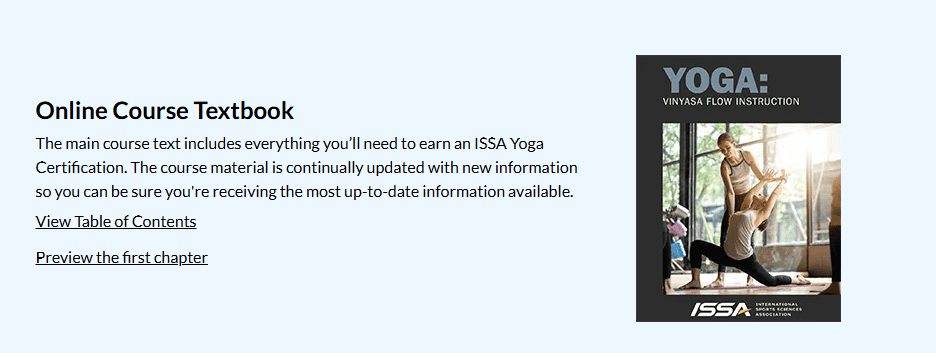
The textbook covers very detailed information. I honestly thought it would just talk about the history of yoga and then list a bunch of poses but it didn’t. It has:
- Different styles of yoga (expected that)
- History of yoga (expected that too)
- Content on structural and functional movement for all parts of the anatomy, like foot and ankle complex, shoulder girdle, and the neck (didn’t expect that)
- Yoga applications of functional movement with poses like upward-facing dog, twisting triangle, and tree pose
The textbook also breaks down a big middle chunk of the content into different yoga poses, specifically seated poses, standing poses, forward bends, backbends, arm balances, inversions, and twisting poses.
The final third focuses on being a yoga instructor, teaching pranayama, setting up a class design based on the principles of sequencing, communicating and queuing in nonverbal and verbal ways, and how to be an inclusive yoga instructor for people like beginners, those who have injuries, or those teaching prenatal yoga.
The content finishes with all the things you need to know about running a professional yoga practice, from your legal considerations to client confidentiality to marketing, building your brand, and understanding how to use the philosophy of yoga in your practice.
I honestly expected it to be mostly mundane history lessons and then the basic how-to-set-up-a-business lessons. I was very impressed with how thorough the sections were on structural and functional movement, as well as the application of that movement to different yoga poses.
Career Support
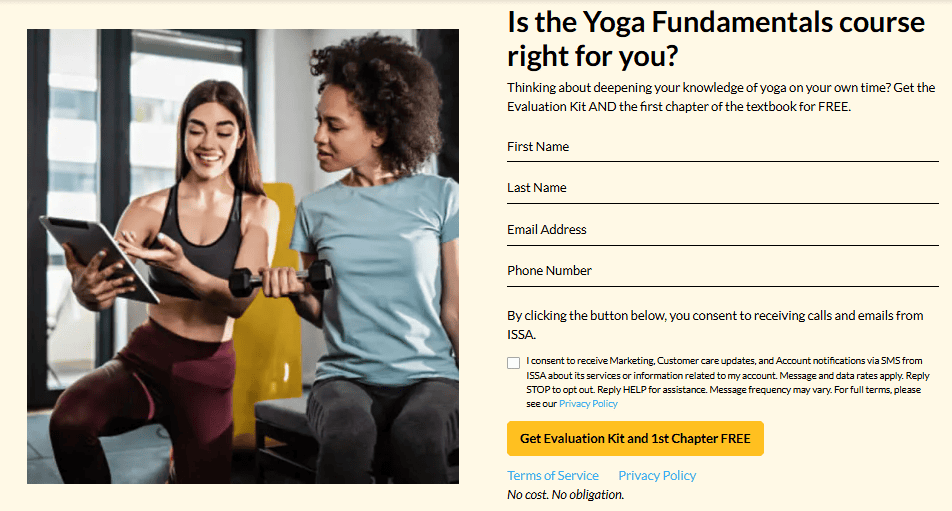
So what happens after you take the course?
ISSA has a whole section for career support and other business resources. It’s part of why I think their costs are well worth the investment.
This includes:
- A guide for setting up a yoga business step-by-step
- Resources to create your own website
- Fitness business tips
- A whole section on how to interview for jobs
- Discounts and access to personal health coverage as someone who is self-employed
- Access to professional liability insurance (so important but often overlooked)
- ISSA Career Connect
Ok, so all of those are great, but I want to focus on the last three.
ISSA Career Connect is a platform where you can see live job postings. So if you are nearing the end of your Yoga course, about to take the final exam, you can check for jobs in your area (or heck, in an area you want to live) and start applying.
You can actually reach out to HR managers before you’ve finished your cert and say things like “Hey, I am taking this course right now, about to finish in two weeks, and would love to apply for this job.” Or whatever.
ISSA has partners all over, and those partners are institutions actively looking to hire. Right. Now. I was so surprised when I reached out through this platform at how many HR managers were like, “Oh my gosh, we need someone to start right away. Can you start tomorrow?”
That’s really inspiring.
Now, let me circle back to the other two on my talk-more-about-them list:
So many people who start as yoga instructors or personal trainers overlook how important it is to manage things like a real business. I get it; real businesses are complicated, and you kind of need scale to make the costs worth it.
That said, as soon as you start to scale, look into the health insurance and liability insurance they offer. As someone who has been self-employed for a long time, I can tell you that finding affordable health insurance is not always easy, so I was tickled pink to see that they had partnered with other companies for affordable rates, and I was even more impressed that they offered liability insurance from another provider.
Summing Up
The Yoga Fundamentals course through ISSA teaches just that: yoga fundamentals. You don’t need any background in yoga to take this course and start practicing and teaching. It combines a lot of information about yoga theory with the science of functional movement and the practical application of yoga.
This is a highly rewarding course to take, in my opinion, with actionable information that includes the same type of career support and customized templates to help you build classes. If you are looking to add something like yoga classes to your existing practice at a gym, this is a good course. You can easily complete it within a few months at an affordable rate and start increasing the courses you can teach as a trainer.
Alt Protein Team is a team of professionals and enthusiasts committed to bringing you the most up-to-date information on alternative protein, health and wellness, workouts, and all things health-related. We’ve reviewed a lot of products and services so you don’t have to guess when you spend your hard-earned money on them. Whether you want to shed some pounds, build lean muscle or bulk, we can help you figure out what you need to do and what you need to have to achieve your goals.

